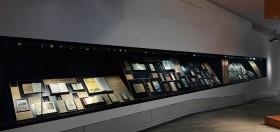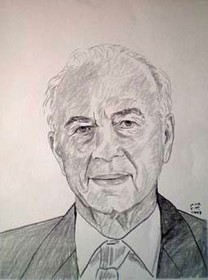
View of the cabinet exhibition “In a foreign country. Publications from the Displaced Persons Camps” in the basement of the Libeskind Building.
© Jewish Museum Berlin, photo: Jens Ziehe
In our cabinet exhibition “In a foreign country” we explore the publishing operations of survivors and refugees, the so-called displaced persons (DPs) who were stranded in occupied Germany after 1945. For this show we selected the widest variety of genres: schoolbooks, Judaica, volumes of poetry and prose, historical documentation, and Zionist pamphlets.
They all have two things in common: first, the quality of the paper these post-war printers used was extremely bad. Second, they all come from the Berlin State Library, whom we’re hosting for this exhibition due to its historically valuable collection of DP literature.
With one little exception. → continue reading
Remembering 4 November 1995
Twenty years ago today, 4 November 1995, Israel prime minister, Yitzhak Rabin, was assassinated following a peace rally in central Tel Aviv. Mirjam Wenzel was there.
“It was a mild evening at Kikar Malchei Yisrael (Kings of Israel Square, now Yitzhak Rabin Square) in the middle of Tel Aviv, where throngs of people had gathered under signs of shalom achshav (peace now) to show their support for Rabin and Shimon Peres and their push for peace. The national religious movement had grown more hostile towards the government in recent weeks, and the media had been reporting its demonstrations with posters of Rabin in a SS uniform. No one could imagine, at least not within my circles, that this movement could turn deadly. From the Tel Aviv office of the Friedrich Ebert Foundation, where I had a semester internship, the Oslo Accords were viewed as a political and economic fact. → continue reading
The Many Faces of Isaac and Ismael, Part 4
Our special exhibition, “Obedience. An Installation in 15 Rooms by Saskia Boddeke & Peter Greenaway,” has been extended until 15 November 2015. The multimedia art installation takes on the sons’ perspectives of this biblical story, when Abraham intended to sacrifice his son in fulfillment of God’s command. In a film projection at the beginning of the exhibition, visitors are greeted by children, youth and young adults with the words, “I am Isaac” or “I am Ismael,” in a variety of languages.
There’s an interactive component to the exhibition, located in the Eric F. Ross Gallery on the ground floor of the Libeskind Building: A video box where visitors can express these words in their own way and, in so doing, more strongly identify with the child perspective of this story of the attempted sacrifice. We’ve presented a small selection of these video clips on the blog over the last several months.
Lisa Albrecht, continuing her task of compiling the clips, has concluded that Isaac and Ismael not only have many faces, but also many names.
However, not all Museum guests are so ‘obedient’ in fulfilling the video box’s intended purpose: → continue reading

